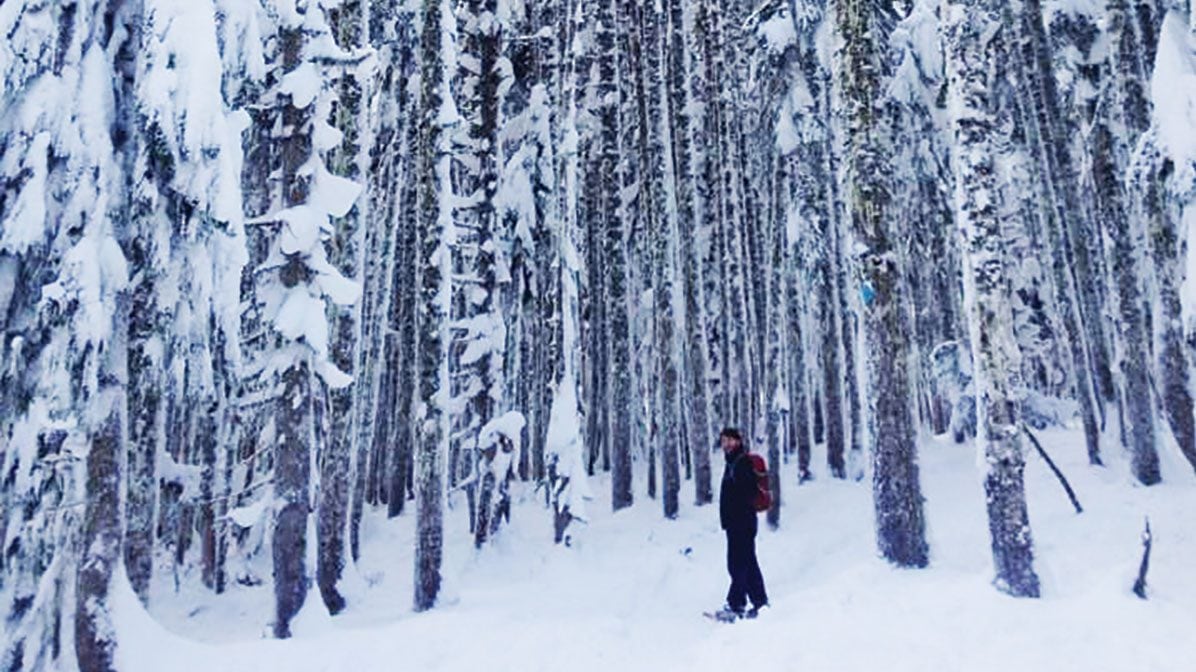Snowshoeing is one of the most accessible winter activities.
Unlike skiing or snowboarding, you don't need several hundred dollars and an REI catalog of high-end equipment to get started. All it takes is some warm clothing, about $15 to rent snowshoes and trekking poles and, since you'll be tromping around in freezing temperatures with what feels like tennis rackets strapped to your feet, a little bit of spirit. No lift tickets or lines for the chair ride. The only limit is how much you can handle physically.
But hey, don't take my word for it. Maybe you're more apt to listen to a guy named Chopper.
"If you can walk," says the mononymous operator and lead guide at Mt. Hood Adventure, "you can snowshoe."
As you might guess, Chopper is enthusiastic about cold-weather recreation. When he's not shepherding a string of snowshoers on 2- to 6-mile moonlight treks, he's bushwhacking solo through the woods. But the health and well-being of those who either take tours or rent gear from his company—especially first-timers—are his primary concern.
CHOPPER'S GEAR GUIDELINES FOR SNOWSHOEING
Guideline 1: "Never sweat from the inside out."
You may be walking, but this is an aerobic activity and sweating is inevitable. The right clothing will prevent that "rode hard, put away wet" feeling at the end of the trek. Start with a base of wicking long underwear. Continue to build with breathable softshell pants made from a flexible fabric that won't restrict movement. They should also be coated for water resistance. Look for similar features in a jacket—bonus if it has vented, zipped sides.
Guideline 2: "If your feet aren't happy, you can't be happy."
Pac boots with thick, rubber shells and liners rated to minus 25 Fahrenheit is sufficient for most snowshoers. Anyone pitching a tent for overnight stays should upgrade to a version that's appropriate for temperatures down to 40 below. Some boots are made specifically for snowshoes—look for the molded leather outcropping on the heel, which helps keep the back from slipping if you're really moving.
Guideline 3: "Poles come in handy for all kinds of things."
Some people hate using what may seem overpriced, fancy metal walking staffs. But poles, whether made specifically for winter weather or the trekking variety with attachable snow baskets, have many uses beyond providing stability on rough terrain. "You can use them as a probe, you can use them as a splint," notes Chopper.
Guideline 4: "If the snow's coming down sideways, having a pair of goggles is the way to go."
These do not have to be extravagant. Chopper is a clear-lens kind of guy. Sunglasses can work, too.
Guideline 5: "You lose the majority of heat from your head and neck area."
Once again, waterproof is the way to go for headwear. Chopper sports a Marmot PreCip ball cap and tops that with a beanie when it's cold. Trapper hats provide ear coverage and are ideal during steady snowfall. For strenuous treks, earmuffs or headbands are optimal since they cover less surface area. Pack a balaclava for face protection in extreme or emergency conditions.
SNOWSHOEING ROUTES ON MOUNT HOOD
EASY: Trillium Lake Loop
Distance: About 5 miles
During summer, Trillium Lake is a bit of a snooze—too short, too flat, teeming with tourists. But that all changes once the snow begins to fall. The route gets a little bit longer because you'll be plodding in from the Trillium Lake Sno-Park lot rather than driving to the day-use area next to the water. And about a mile in, you'll leave behind most of the crowd that came up to make snow angels. Forest Road 2650 will be free of cars in winter, so traipse along the wide, sloped path that's blanketed in powder until you hit a fork. A left turn will get you to the lake more quickly, but you owe it to yourself to navigate the twists and turns before the reward. So veer right, and explore the prairie land, a thick forest of Doug firs and the Summit Meadows Pioneer Cemetery and then, eventually, Trillium Lake itself. On a clear day, Mount Hood towers above a hill of pines. But even if it's overcast and snowing, the lilac gray ice bleeds into a sky the same shade—you almost can't tell where one ends and the other begins. And it's just as breathtaking.
Directions: Travel 3.1 miles east of Sand on US 26 to about 2.5 miles east of Timberline Road. Follow the signs to Trillium Lake and turn right into the Sno-Park. Sno-Park permit required Nov. 1-April 30.
MODERATE: Twin Lakes
Distance: About 7 miles
If you've seen one lake in the Mount Hood National Forest, it's easy to assume you've seen them all. What makes the Twin Lakes unique is right there in the name. There are two watering holes to visit, though you'll get a different view at each thanks to elevation. From the Frog Lake Sno-Park, turn right onto the Pacific Crest Trail. At an intersection, veer right again to take Twin Lakes Trail No. 495. From there it's a gentle climb under the thick boughs of old growth sagging with snow. You'll reach the first lake after ambling down a ridge around 2 miles in. There's a campground with your pick of what should be wide open lakefront log seating during snowshoe season. The frozen patch of water is ringed by towering evergreens that look as if a giant cake decorator liberally iced each gnarled branch. The spur to Upper Twin is narrower and steeper, deterring many even in warm temperatures. As the trail climbs, you can look back down at the lower lake before you reach the second one, where the tip of Mount Hood will be peeking over a grove of trees.
Directions: Take US 26 east past the junction with OR-35 to the Frog Lake Sno-Park.
STRENUOUS: Frog Lake Butte
Distance: About 6 miles
When the snow starts falling on the mountain passes, there's a trailhead tucked into the trees just off Highway 26 that looks as if it could be a parking lot in an Alaskan village. Frog Lake Sno-Park is typically bustling with activity, but you can lose much of that company by taking one of the more punishing routes from that base. Begin by heading right on Forest Road 2610 and connect with Frog Lake Butte Road, which was paved to accommodate vehicles servicing a communication tower on the bluff. But this is no flat stroll. About a half-mile in, your lungs begin to burn, and from there the trail is steep and unforgiving, climbing about 2,000 feet. Once you reach the top, you'll never be so grateful for a patch of level land. At nearly 5,300 feet, there's a whole lotta view on that wide-open butte. As you take in Mount Hood, the rolling hills flecked with lakes, and even Mount Jefferson far to the south, it might feel as if you're floating on a cloud above Oregon.
Directions: Take US 26 east past the junction with OR-35 to the Frog Lake Sno-Park.
Your Guide to Making the Most of Winter in Portland
A Guide to Snowshoeing on Mount Hood
When Oregon's Ski Resorts Start Feeling Claustrophobic, Blaze a Trail to the Backcountry
Yes, it Is Possible to Bike Through Snow. Here's How.
Snowvana Brings One of Oregon's Most Daring Freeskiers Home
From Trikking to Snow Kiting, Here are Some of Oregon's More Obscure Winter Sports
Five Great Hikes to Watch the Oregon Coast Get Battered This Winter
We Went Pub Crawling on the Mount Hood Express to Find the Best Bars on the Way Down From Timberline

